
Source: Wikimedia. This figure is in the public domain.
What’s new?
The Engineer reported that a recent article in the journal Renewable Energy used computer simulation to conclude that vertical axis wind turbines can be clustered together to increase total energy output, unlike traditional horizontal axis wind turbines.
What does it mean?
The two basic types of wind turbines differ by how the turbine rotates when the wind is blowing. In the example in the center of the figure at the top of this blog, the three blades rotate around a horizontal axis, that is, an axis perpendicular to the figure and parallel to the ground; it is a horizontal axis wind turbine (HAWT). In the two others, the rotation is around a a vertical axis, that an axis that is parallel to the figure and perpendicular to the ground; each of these two examples is a vertical axis wind turbine (VAWT).
HAWTs are increasingly used to generate electricity, but a well known problem is that, in an array of such turbines, the turbines first struck by the wind generate turbulence that reduces the energy able to be captured by trailing turbines. Previous research had shown that VAWTs seem to have the opposite effect, in which the capture of energy by trailing turbines is actually enhanced by the earlier turbines. Note that, of course, no combination of turbines can capture more energy than the total energy contained in the wind.
Computers have enabled many wonderful accomplishments for us (my latest is the Merlin bird identification app on my phone). For engineers, computer simulation is a wonderful tool. Computer simulation enables us to create a mathematical model of a real world system, described in computer code, and then to perform experiments on that model. A crucial part of simulation is to validate the model, that is, to compare its output with data from the actual system in order to confirm that it faithfully models the real world in the crucial measurements. Depending on how realistic the underlying model is, we can then make predictions about how actual devices will perform in the real world.
In this article, the engineers created a two-dimensional CFD (Computational Fluid Dynamics) model of a field of VAWTs, performed experiments by changing the layout of the turbines, and then predicted what will occur with real turbines. Obviously, they can perform many more experiments at much less cost than if they did the experiments with actual turbines.
Engineering improves products in three ways: design, manufacture, and use. In the design of a wind turbine, the engineers select a HAWT or VAWT, decide on the size and shape of the blades, determine the height of the tower, select materials for each part of the device, and so forth. In manufacture, engineers select and then continuously improve the processes for making each part, for assembling the device, and for installing it at its location. Finally, engineers make decisions about when the turbine will be operated, how its output will be used within the larger electric grid, select and implement a maintenance schedule, and eventually decide when to take the device out of service. The article in Renewable Energy is an example of improvements in the use of the turbines, that is, in their layout, but it also illustrates how design and use are interrelated. Renewable energy is coming on like gangbusters because of changes in design, manufacture, and use.
What does it mean for you?
Computer simulation is an amazing tool. The minute you ask any question starting with “what if …?” you should think about using a computer simulation. As an industrial engineer, I know about the use of stochastic simulations (ones that incorporate random events) for modeling production systems, enabling the asking and answering of “what if?” questions about inventory, equipment layout, scheduling, and more.
One of the most important facts about a computer simulation, which I have mentioned already, is that the results are only as good as the ability of the model to replicate the real world. I tell my students that they must practice saying, to themselves and to others, “it’s only a model,” said with a shrug of the shoulders. Engineers can all too easily fall into the trap of saying “the VAWT array functioned best in this layout,” when they really mean “the simulation of the VAWT array functioned best in this layout.” As George Box is often quoted as saying, “all models are wrong; some are useful.” You must be wary of engineers – and others – who aren’t careful in their language about predictions from models.
Renewable energy is coming on like gangbusters. Whether this progress and others will be fast enough and sufficient to save the world remains to be seen.
Where can you learn more?
This is my second blog post titled “It’s only a model.” The first one is here.
IISE (the Institute of Industrial & Systems Engineers) has a Division devoted to modeling and simulation. There are many useful computer packages: AnyLogic, Arena, Flexsim, Simio, Simul8, and more. The Winter Simulation Conference is a great source of current information about theory and application. Industrial engineering overlaps with many business areas and computer simulations can also be used, for example, in financial forecasting.
Engineering simulation can be used any time the mathematical equations describing a real world system are too complicated to be solved in general; they are instead solved numerically for the specific case being studied and are often solved using approximations. The applications and computer packages are too numerous to list.
This page from the US Department of Energy gives a good overview of developments in wind turbines.
If you aren’t seriously worried about global climate change, this page from NASA should do it for you.

This work is licensed under a Creative Commons Attribution 4.0 International License.
One thought on “It’s only a model (take 2)”